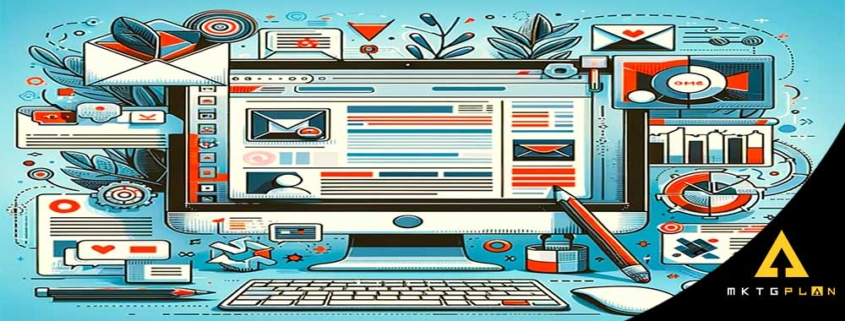The Ultimate Guide to Crafting an Email Newsletter
Comprehensive Guide to Creating a Successful Email Newsletter
Email newsletters are an integral part of every successful email marketing strategy. Not only do they provide your customers with valuable insights, but they also play a significant role in driving them to purchase more of your products and engage more with your brand.
Evidence shows that newsletters are an economical marketing tool, with an impressive average return on investment of $36 for every $1 spent. So, let’s delve into a comprehensive guide by our very own MKTG Plan, a web design and SEO agency, on how to create a compelling email newsletter that won’t let you miss a single aspect.
The Preliminary Stage: Starting your Email Newsletter
Email newsletters involve juggling a myriad of tasks simultaneously. You need to design them properly to fit various inboxes and read well on multiple devices, create engaging calls to action with intriguing subject lines, carefully proofread your copy, and make sure you don’t trip any spam triggers, all while abiding by email laws (yes, they do exist).
Steps to Create An Outstanding Email Newsletter for your Brand
Step 1: Select an Email Newsletter Tool
Your first task is to select an email newsletter tool that aligns with your brand’s objectives, budget, and technical expertise.
HubSpot’s free tool is an excellent choice, offering ease of use even for those unfamiliar with drag-and-drop page editors, thanks to its intuitive design. It’s part of HubSpot’s Marketing Hub, a marketing automation software designed for businesses of all sizes.
HubSpot also offers a wide range of integrations and alternative email newsletter design tools, such as BEE Pro, making it a great point to start.
Step 2: Define The Goal of Your Newsletter
Before a single word is written, ensure you are well aware of the goal of your newsletter and how it fits into your broader content strategy. For instance, should your newsletter drive more traffic to your blog? Generate more leads? Or promote new products and services?
Once you’ve outlined your goals, your next decision to flow from these.
Moreover, consider key performance indicators for each of these goals that reflect your overall business objectives, not just “how many people opened it.”
Step 3: Choose a Template and Collect Your Content
After defining your newsletter’s goal, choose a relevant template and gather content. If you’re new to email design, consider using ready-made templates, such as those offered in HubSpot’s email tool.
Typically, depending on how early you set your newsletter’s goal and its intended frequency, you can actively or passively search for content between two email sends. Look for content in various places such as your company’s blog, social media accounts, lead-generation offers, internal newsletters, and training documents.
Step 4: Personalize the Template
A template is an excellent launchpad, but personalization is key. Using a template before writing the copy helps visualize the space you have for promoting content and prevents overcrowding.
An ideal template is not necessarily glamorous. It should be easy for recipients to read, scan, and click on email elements. HubSpot’s AI Email Writer can help you design your newsletters to meet these requirements by generating your copy.
With 41.6% of people opening their emails on mobile devices, your design should also be mobile-friendly.
Step 5: Set the Size of Your Email Newsletter
Email newsletters should be set to an established width and height that wouldn’t distort their design on email clients. Most providers default a newsletter’s width to 600px, so ensuring your newsletter design fits this universal width is key.
As for height, it can be as long as you want it to be, but keep in mind that people are less likely to click through to your website if the email is too long. A good rule of thumb is to make your email short enough to prevent your recipients from scrolling endlessly before reaching the end.
Step 6: Add In Your Core Content
Now, it’s time to populate your template with words and pictures. This core content should ideally be brief, yet compelling, to encourage click-throughs. Also, don’t forget to include relevant images to support your copy and triple-check for errors before sending out your email.
Step 7: Personalize Using Tokens and Smart Content
Personalizing your newsletter helps create a sense of belonging among your subscribers. You can achieve this by segmenting your emails to fit your audience’s interests and by introducing personalization tokens. But remember—limit the tokens to a comfortable level to prevent making your readers uncomfortable.
Smart content can further enhance the personal touch by showing different content to different parts of your audience.
Step 8: Choose Your Subject Line and Sender Name
A recognizable sender name can significantly impact open and click-through rates. Similarly, a concise and actionable subject line can dramatically improve the clickability of your email. Try A/B testing different formats to find what works best for your audience.
Step 9: Include Alt Text and Plain Text for Support
Alt text and plain text are critical. The former helps users understand the content of an image if the picture doesn’t load, while the latter ensures readability across various email clients.
Step 10: Ensure Legal Compliance
Before hitting the “Send” button, it’s crucial to ensure legal compliance according to laws such as CAN-SPAM and GDPR, which require certain information and permissions in your emails.
Step 11: Test Across Various Browsers and Email Providers
To account for different email code interpretations among various browsers and email providers, be sure to test your newsletter across the most popular platforms.
Step 12: Send Your Email
Once you green light your newsletter by checking all the boxes including branding and legal compliance, it’s time to click the send button. Then, you patiently wait for the analytics to kick in.
Step 13: Analyze and Iterate
Once you fetch the data, measure how your newsletter performed based on the goals you set in step one. Identify the elements that contributed the most to your goal and use the insights to craft an even better newsletter for your next send.
The Utilization of Email Newsletters as a Marketing Strategy
Email newsletters remain as one of the effective means to rev up your marketing strategy. By developing and distributing well-crafted newsletters, businesses can not only increase their brand recognition but enhance trust with their subscribers. They serve an essential role in strengthening the relationship with customers by providing timely and relevant information, spurring customers to make more purchases, and promoting continuous engagement with the brand.
One of the considerable advantages of utilizing email newsletters in your business strategy is its cost-effectiveness. For every dollar spent on newsletter marketing, businesses typically experience an average return on investment (ROI) of up to $36.
Creating an enticing newsletter may seem daunting; however, MKTG Plan, a renowned SEO and web design agency in Miami, presents an extensive guide to help you create compelling email newsletters without omitting crucial aspects.
Conclusion
Email newsletters are vital for any scalable email marketing strategy. By following the steps highlighted above, you can craft an attractive and effective newsletter that encourages more conversions and helps your business grow.



